The Asustor AS7110T is a SMB virtualization and storage NAS solution highlighted by its Intel Xeon 9th generation Quad-Core CPU. With its 10 drive-bays and highly customizable build, the AS7110T offers a range of different options for budgets of all kinds. As such, it can easily scale as your business grows for a total of 160TB in raw capacity (using 10 x 16TB HDDs), which can be upped to 352TB when using expansion units. Moreover, its online capacity expansion feature allows users to replace hard drives inside the NAS without downtime. The AS7110T also fully supports iSCSI/IP-SAN, NFS, virtualization and Docker apps, and is VMware, Citrix and Hyper-V ready.
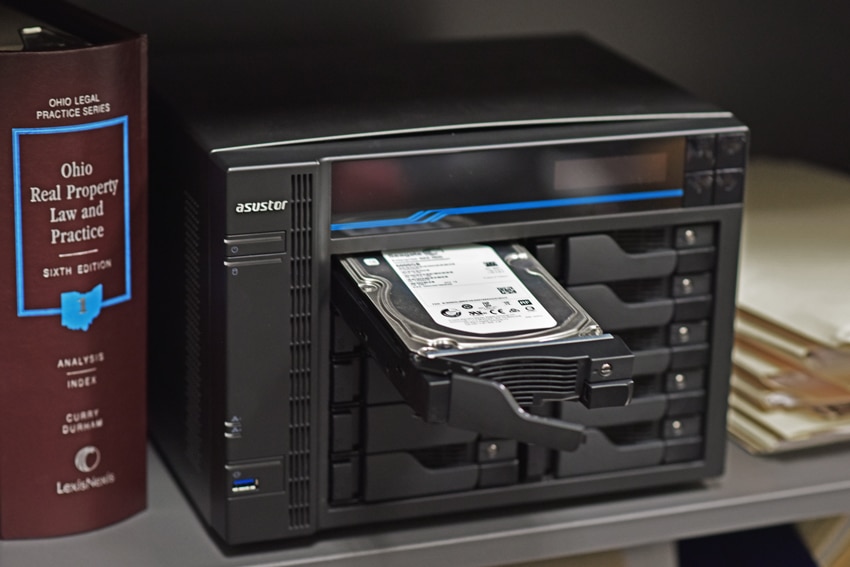
Under the hood, the Asustor AS7110T is powered by an Intel Xeon E-2224, a mid-range Quad Core 3.4GHz up to 4.6GHz CPU (via Intel Turbo Boost Technology) released in 2019 that features an x64 64-bit architecture, 8M cache. We recently saw this Intel CPU inside the Lenovo ThinkStation P330. The AS7110T also comes standard with 8GB of server-grade DDR4-2666 ECC memory (which can be increased up to 64GB via two 32GB sticks).The ECC memory can detect then correct the most common types of data corruption on the fly, which makes it ideal for NAS devices like these, as it helps promote system stability and prevent data loss due to unexpected power losses or surges. In addition, the AS7110T can be configured with two M.2 NVMe SSD ports for fast caching and features two USB 3.2 Gen 2 ports at the rear.
The all new Asustor AS7110T NAS also comes equipped with an Aquantia 10-Gigabit Ethernet port and three Aquantia 2.5-Gigabit Ethernet ports; the former connectivity is quoted to deliver up to 1,181MB/s read and 1,178MB/s write, while the latter connection is expected to reach speeds up to 848MB/s read and 847MB/s write.
Backed by a nice 5-year warranty, the Asustor AS7110T starts around the $1,000 mark for the diskless model. Our configuration includes the standard 8GB of DDR4 RAM and eight 14TB WD Red HDDs.
Asustor AS7110T Specifications
| CPU Model | Intel Xeon E-2224 |
| CPU Architecture | x64 64-bit |
| CPU Frequency | Quad Core 3.4GHz up to 4.6GHz |
| Memory | 8GB DDR4 ECC SO-DIMM |
| Memory Module Pre-installed | 8GB (1 x 8GB) |
| Total Memory Slots | 2 |
| Memory Expandable up to | 64GB (2x 32GB) |
| Flash Memory | 8GB USB DOM |
| HDD | 10 x SATA3 6Gb/s; 3.5″/2.5″ HDD/SSD |
| M.2 Drive Slots (SSD Cache) | 2x M.2 PCIe (NVMe) / SATA *M.2 2280, 2260, 2242. |
| Maximum Internal Raw Capacity | 160 TB (16 TB HDD X 10, Capacity may vary by RAID types) |
| Maximum Drive Bays with Expansion Unit | 22 |
| Maximum Raw Capacity with Expansion Units | 352 TB (16 TB HDD X 22, Capacity may vary by RAID types) |
| Expansion | Front USB 3.2 Gen 1 x 1; Rear USB 3.2 Gen 2 x 2 |
| Network | 10 Gigabit Ethernet x 1; 2.5 Gigabit Ethernet x 3 |
| HDMI Output | N/A |
| System Fan | 120mm x 2 |
| LCD Panel | |
| Power Supply Unit / Adapter | 350W x1 |
| Input Power Voltage | 100V to 240V AC |
| Certification | FCC, CE, VCCI, BSMI, C-TICK |
| Power Consumption | 78.7W (Operation); 40.1W (Disk Hibernation); 5.8 W (Sleep Mode) |
| Noise Level | 22dB (HDD idle) |
| Operation Temperature | 0°C~40°C (32°F~104°F) |
| Humidity | 5% to 95% RH |
| Size | 215.5(H) x 293(W) x 230(D) mm |
| Weight | 7.1 (kg) / 15.62 (lb) |
Design and build
Weighing in at over 15 pounds (diskless) and measuring 8.5 inches high and 11.5 inches in width, the AS7110T is a sizable NAS device. The AS7110T also features a nice, all-black front panel design.
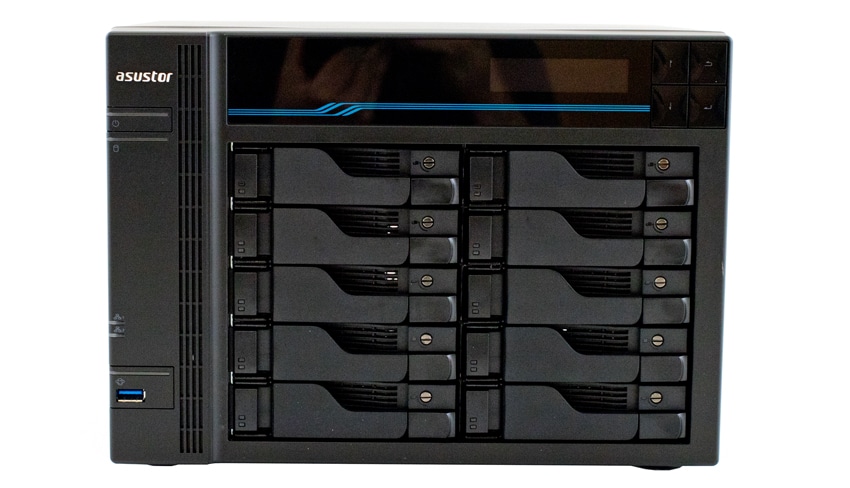
As for configurations, users can populate the AS7110T with 10 x SATA3 6Gb/s 3.5″ HDDs or 2.5″ SSDs. To install a drive, all we had to do is press the button on the lower part of the disk tray to release the latch, and then pull it out. This isn’t a tool-less NAS, so you will have the secure the drives with four screws.
The LCD display at the top right is very nice. The NAS name and IP address will display on the LCD panel after powering on the device and is used to configure NAS settings and check system information. To navigate the menus, the buttons are handily to right side of the LCD panel: Up, down, back and confirm buttons. Overall, navigating through the interface via these buttons is snappy.
- Touch Backup, which runs the backup function for the USB port on the front panel.
- Network, which displays the LAN and WAN IP address and subnet mask.
- Storage, which allows you to see the total capacity of the volume, the amount of space in use, and the free space remaining.
- Temperature, which displays the HDD, system and CPU temperatures
- Operation, which allows you to shutdown or restart the AS7110T
- Configuration, which allows you to configure things like the server name and addresses
Along the left side are the Power, system status, and network LED indicators with a USB 3.0 port below them. Each installed hard disk has a LED indicator as well, which lights green when ready (or flashing when data access is in progress).
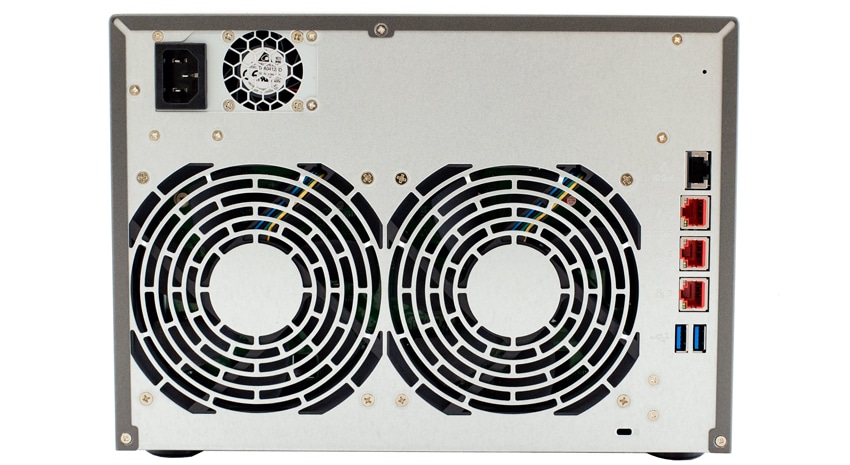
Turning the AS7110T reveals most of the connectivity, which surrounds the dual system fans:
- Power supply unit connector
- Reset button
- 10G RJ45 port
- Three 2.5G RJ45 ports
- USB 3.2 Gen 2 port
- K-lock
Asustor AS7110T Performance
Enterprise Synthetic Workload Analysis
Our enterprise shared storage and hard drive benchmark process preconditions each drive into steady-state with the same workload the device will be tested with under a heavy load of 16 threads with an outstanding queue of 16 per thread, and then tested in set intervals in multiple thread/queue depth profiles to show performance under light and heavy usage. Since hard drives reach their rated performance level very quickly, we only graph out the main sections of each test.
Preconditioning and Primary Steady-State Tests:
- Throughput (Read+Write IOPS Aggregate)
- Average Latency (Read+Write Latency Averaged Together)
- Max Latency (Peak Read or Write Latency)
- Latency Standard Deviation (Read+Write Standard Deviation Averaged Together)
Our Enterprise Synthetic Workload Analysis includes four profiles based on real-world tasks. These profiles have been developed to make it easier to compare to our past benchmarks as well as widely-published values such as max 4k read and write speed and 8k 70/30, which is commonly used for enterprise drives.
- 4K
- 100% Read or 100% Write
- 100% 4K
- 8K 70/30
- 70% Read, 30% Write
- 100% 8K
- 8K (Sequential)
- 100% Read or 100% Write
- 100% 8K
- 128K (Sequential)
- 100% Read or 100% Write
- 100% 128K
In the first of our enterprise workloads, we measured a long sample of random 4K performance with 100% write and 100% read activity. Looking at IOPS, the best configuration for the Asustor AS7110T was under iSCSI connectivity, which recorded 2,300 IOPS write and 632 IOPS read. CIFS showed 2,229 IOPS write and 180 IOPS read.
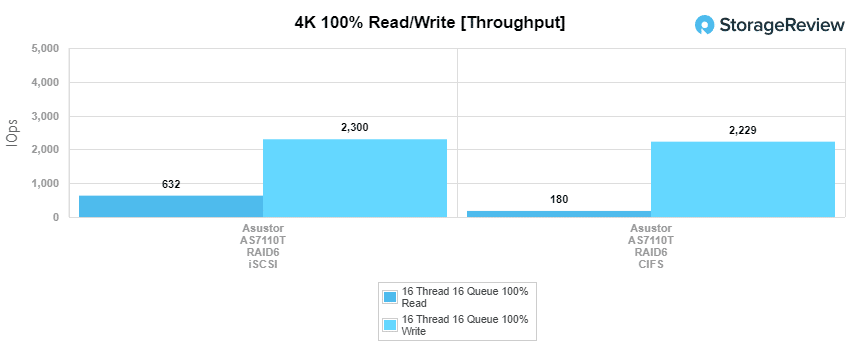
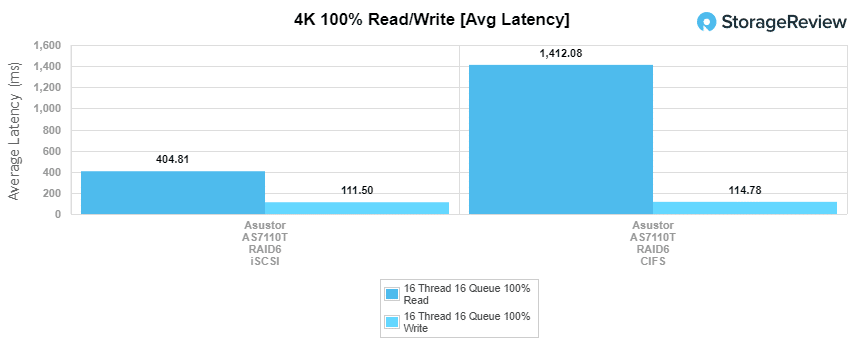
For max latency, the Asustor AS7110T recorded 2,261.3ms read and 2,121ms write via iSCSI. In CIFS, the NAS posted 2,817ms read and 2,108ms write.
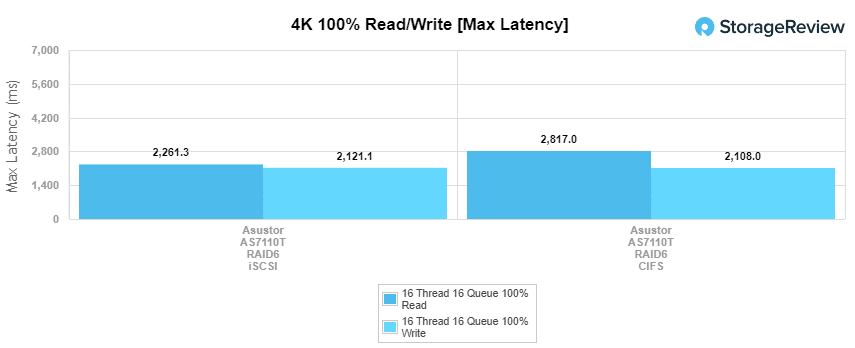
When looking at the standard deviation of random 4K performance, the AS7110T recorded its best read and write performance in CIFS with 100ms and 145.4ms, respectively. Using iSCSI connectivity, it posted 280.6ms read and 188.4ms write.
Our next benchmark measures 100% 8K sequential throughput with a 16T/16Q load in 100% read and 100% write operations. The AS7110T recorded its best performance (by quite a bit) under iSCSI with 107,259 IOPS read and 125,533 IOPS write.
Compared to the fixed 16 thread, 16 queue max workload we performed in the 100% 4K write test, our mixed workload profiles scale the performance across a wide range of thread/queue combinations. In these tests, we span workload intensity from 2 threads and 2 queue up to 16 threads and 16 queue. In throughput, iSCSI showed a range of 473 IOPS to 666 IOPS while CIFS recorded 233 IOPS and slowing down slight by the end with 230 IOPS.
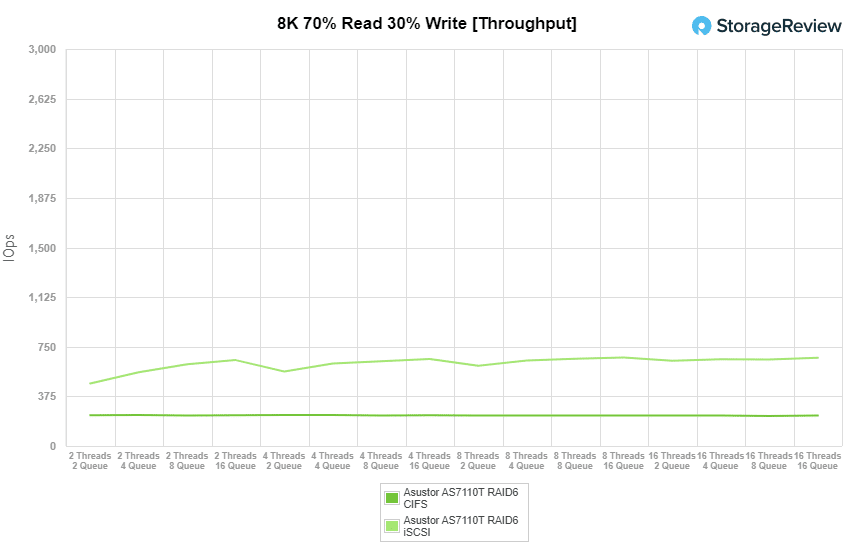
In average latency, iSCSI connectivity showed a range of 8.43ms to 384.2ms and 11.1ms, while CIFS posted 17.06ms to 1,106.6ms.
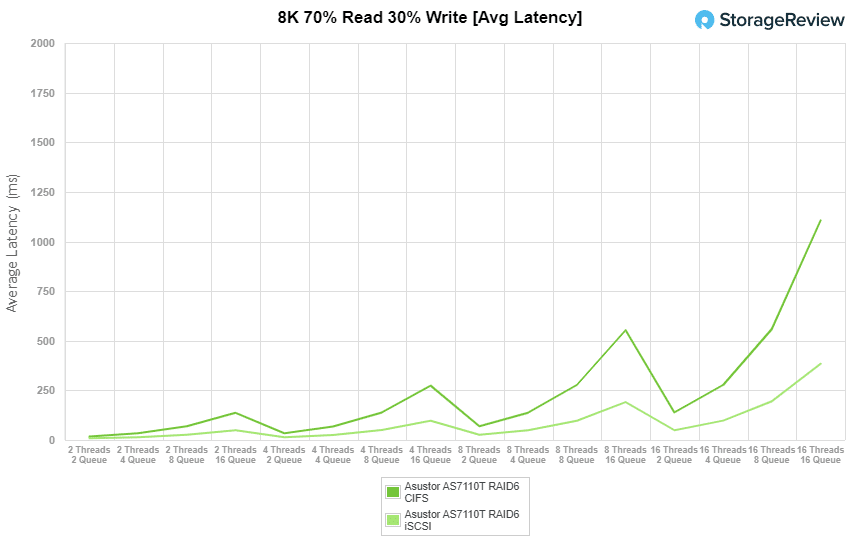
In maximum latency, iSCSI connectivity showed a bit higher performance with a range of 1,005.2ms to 4,240ms. In CIFS, the AS7110T showed 874.8ms to 3,849.5ms.
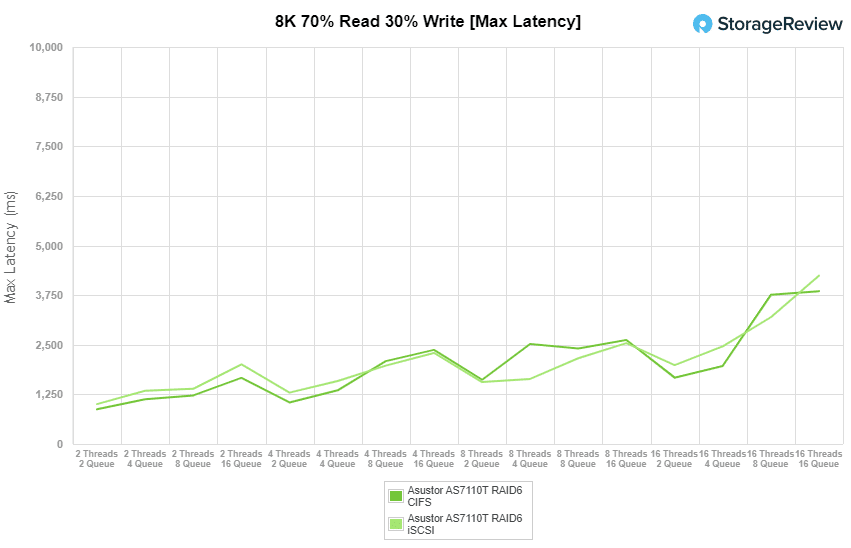
Looking at standard deviation, the AS7110T iSCSI configuration recorded 19.25ms to 396.05ms, while the CIFS configuration showed a range of 24.7 to 412.16ms.
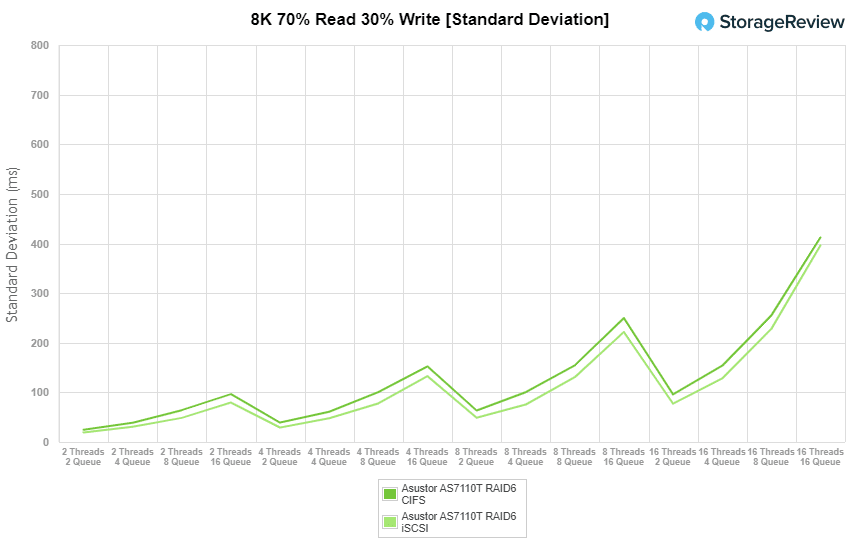
Our last test in our small NAS Synthetic Workload testing is the 128K test, which is a large block sequential test that shows the highest sequential transfer speed. When looking at the 128K performance of 100% write and 100% read activity, the best configuration for the AS7110T was under CIFS connectivity, which recorded 1.16GB/s read and 1.13GB/s write. iSCSI showed 231MB/s read and 1.12GB/s write.
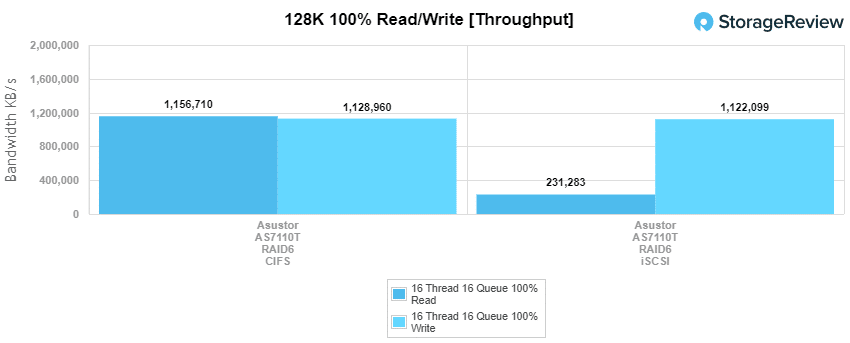
Conclusion
Overall, the AS7110T a nice release from Asustor. The 10-bay NAS is highlighted by an Intel Xeon 9th generation Quad-Core CPU, up to 64GB of server-grade DDR4-2666 ECC memory, two M.2 NVMe SSD ports for caching, one 10-Gigabit Ethernet port, three 2.5-Gigabit ports and a USB 3.2 Gen2 connectivity. The AS7110T can be customized to fit a range of budgets, and can easily scale as a business grows or needs more storage; up to 160TB or 352TB via expansion units. Its online capacity expansion feature also means drive replacement won’t cause any downtime. In addition, the new Asustor NAS fully supports iSCSI/IP-SAN, NFS, virtualization and Docker apps, and is VMware, Citrix and Hyper-V ready.
It houses ten 3.5-inch drive bays that also supports 2.5-inch SSDs, allowing users to build a hybrid storage solution. They can also leverage both capacity and performance via the SSD caching slots.
For this review, we outfitted the AS7110T with eight WD Red HDD drives. In our 4k, the AS7110T recorded 2300 IOPS write and 632 IOPS read in iSCSI, while CIFS showed 2,229 IOPS write and 180 IOPS read. In our 100% 8K sequential test, the NAS posted 107,259 IOPS read and 125,533 IOPS write in iSCSI and 54,488 IOPS read and 36,824 IOPS write in CIFS. During the 128k benchmark, the AS7110T recorded 1.16GB/s read and 1.13GB/s write using CIFS connectivity, while iSCSI showed 231MB/s read and 1.12GB/s write.
For SMBs that are looking for a high quality NAS with plenty of capacity and performance, the Asustor AS7110T is a good choice. For growing businesses, the AS7110T can grow as the business does, expanding capacity and performance along the way.


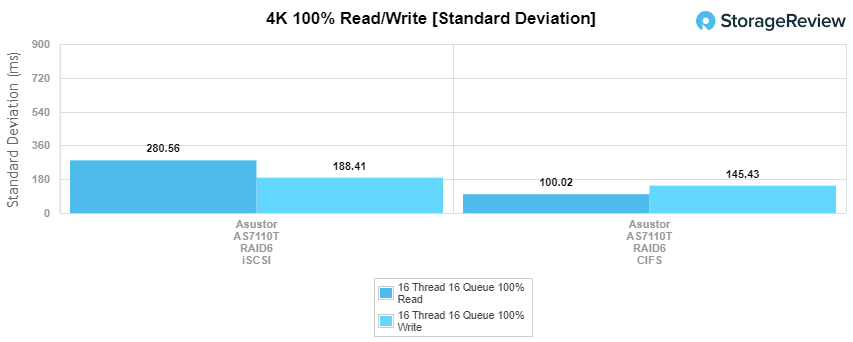
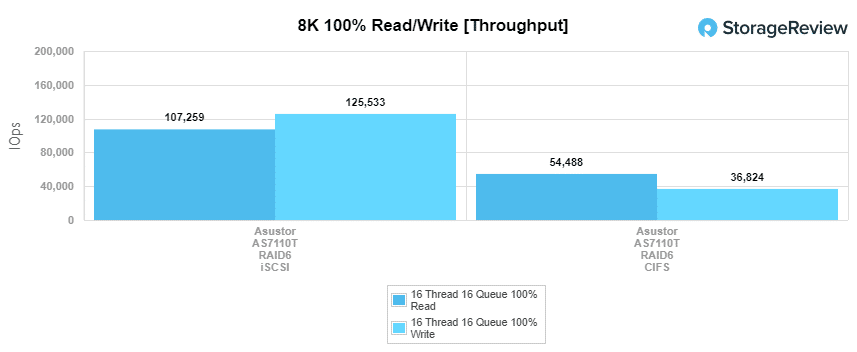


 Amazon
Amazon